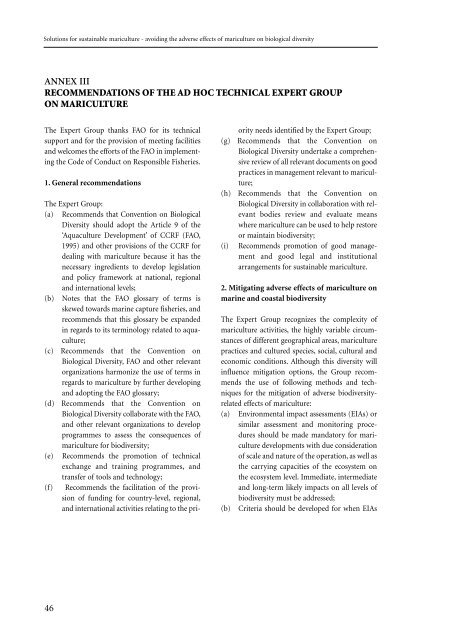Solutions for sustainable mariculture - Convention on Biological ...
Solutions for sustainable mariculture - Convention on Biological ...
Solutions for sustainable mariculture - Convention on Biological ...
- No tags were found...
You also want an ePaper? Increase the reach of your titles
YUMPU automatically turns print PDFs into web optimized ePapers that Google loves.
<str<strong>on</strong>g>Soluti<strong>on</strong>s</str<strong>on</strong>g> <str<strong>on</strong>g>for</str<strong>on</strong>g> <str<strong>on</strong>g>sustainable</str<strong>on</strong>g> <str<strong>on</strong>g>mariculture</str<strong>on</strong>g> - avoiding the adverse effects of <str<strong>on</strong>g>mariculture</str<strong>on</strong>g> <strong>on</strong> biological diversityANNEX IIIRECOMMENDATIONS OF THE AD HOC TECHNICAL EXPERT GROUPON MARICULTUREThe Expert Group thanks FAO <str<strong>on</strong>g>for</str<strong>on</strong>g> its technicalsupport and <str<strong>on</strong>g>for</str<strong>on</strong>g> the provisi<strong>on</strong> of meeting facilitiesand welcomes the ef<str<strong>on</strong>g>for</str<strong>on</strong>g>ts of the FAO in implementingthe Code of C<strong>on</strong>duct <strong>on</strong> Resp<strong>on</strong>sible Fisheries.1. General recommendati<strong>on</strong>sThe Expert Group:(a) Recommends that <str<strong>on</strong>g>C<strong>on</strong>venti<strong>on</strong></str<strong>on</strong>g> <strong>on</strong> <strong>Biological</strong>Diversity should adopt the Article 9 of the‘Aquaculture Development’ of CCRF (FAO,1995) and other provisi<strong>on</strong>s of the CCRF <str<strong>on</strong>g>for</str<strong>on</strong>g>dealing with <str<strong>on</strong>g>mariculture</str<strong>on</strong>g> because it has thenecessary ingredients to develop legislati<strong>on</strong>and policy framework at nati<strong>on</strong>al, regi<strong>on</strong>aland internati<strong>on</strong>al levels;(b) Notes that the FAO glossary of terms isskewed towards marine capture fisheries, andrecommends that this glossary be expandedin regards to its terminology related to aquaculture;(c) Recommends that the <str<strong>on</strong>g>C<strong>on</strong>venti<strong>on</strong></str<strong>on</strong>g> <strong>on</strong><strong>Biological</strong> Diversity, FAO and other relevantorganizati<strong>on</strong>s harm<strong>on</strong>ize the use of terms inregards to <str<strong>on</strong>g>mariculture</str<strong>on</strong>g> by further developingand adopting the FAO glossary;(d) Recommends that the <str<strong>on</strong>g>C<strong>on</strong>venti<strong>on</strong></str<strong>on</strong>g> <strong>on</strong><strong>Biological</strong> Diversity collaborate with the FAO,and other relevant organizati<strong>on</strong>s to developprogrammes to assess the c<strong>on</strong>sequences of<str<strong>on</strong>g>mariculture</str<strong>on</strong>g> <str<strong>on</strong>g>for</str<strong>on</strong>g> biodiversity;(e) Recommends the promoti<strong>on</strong> of technicalexchange and training programmes, andtransfer of tools and technology;(f) Recommends the facilitati<strong>on</strong> of the provisi<strong>on</strong>of funding <str<strong>on</strong>g>for</str<strong>on</strong>g> country-level, regi<strong>on</strong>al,and internati<strong>on</strong>al activities relating to the priorityneeds identified by the Expert Group;(g) Recommends that the <str<strong>on</strong>g>C<strong>on</strong>venti<strong>on</strong></str<strong>on</strong>g> <strong>on</strong><strong>Biological</strong> Diversity undertake a comprehensivereview of all relevant documents <strong>on</strong> goodpractices in management relevant to <str<strong>on</strong>g>mariculture</str<strong>on</strong>g>;(h) Recommends that the <str<strong>on</strong>g>C<strong>on</strong>venti<strong>on</strong></str<strong>on</strong>g> <strong>on</strong><strong>Biological</strong> Diversity in collaborati<strong>on</strong> with relevantbodies review and evaluate meanswhere <str<strong>on</strong>g>mariculture</str<strong>on</strong>g> can be used to help restoreor maintain biodiversity;(i) Recommends promoti<strong>on</strong> of good managementand good legal and instituti<strong>on</strong>alarrangements <str<strong>on</strong>g>for</str<strong>on</strong>g> <str<strong>on</strong>g>sustainable</str<strong>on</strong>g> <str<strong>on</strong>g>mariculture</str<strong>on</strong>g>.2. Mitigating adverse effects of <str<strong>on</strong>g>mariculture</str<strong>on</strong>g> <strong>on</strong>marine and coastal biodiversityThe Expert Group recognizes the complexity of<str<strong>on</strong>g>mariculture</str<strong>on</strong>g> activities, the highly variable circumstancesof different geographical areas, <str<strong>on</strong>g>mariculture</str<strong>on</strong>g>practices and cultured species, social, cultural andec<strong>on</strong>omic c<strong>on</strong>diti<strong>on</strong>s. Although this diversity willinfluence mitigati<strong>on</strong> opti<strong>on</strong>s, the Group recommendsthe use of following methods and techniques<str<strong>on</strong>g>for</str<strong>on</strong>g> the mitigati<strong>on</strong> of adverse biodiversityrelatedeffects of <str<strong>on</strong>g>mariculture</str<strong>on</strong>g>:(a) Envir<strong>on</strong>mental impact assessments (EIAs) orsimilar assessment and m<strong>on</strong>itoring proceduresshould be made mandatory <str<strong>on</strong>g>for</str<strong>on</strong>g> <str<strong>on</strong>g>mariculture</str<strong>on</strong>g>developments with due c<strong>on</strong>siderati<strong>on</strong>of scale and nature of the operati<strong>on</strong>, as well asthe carrying capacities of the ecosystem <strong>on</strong>the ecosystem level. Immediate, intermediateand l<strong>on</strong>g-term likely impacts <strong>on</strong> all levels ofbiodiversity must be addressed;(b) Criteria should be developed <str<strong>on</strong>g>for</str<strong>on</strong>g> when EIAs46
















